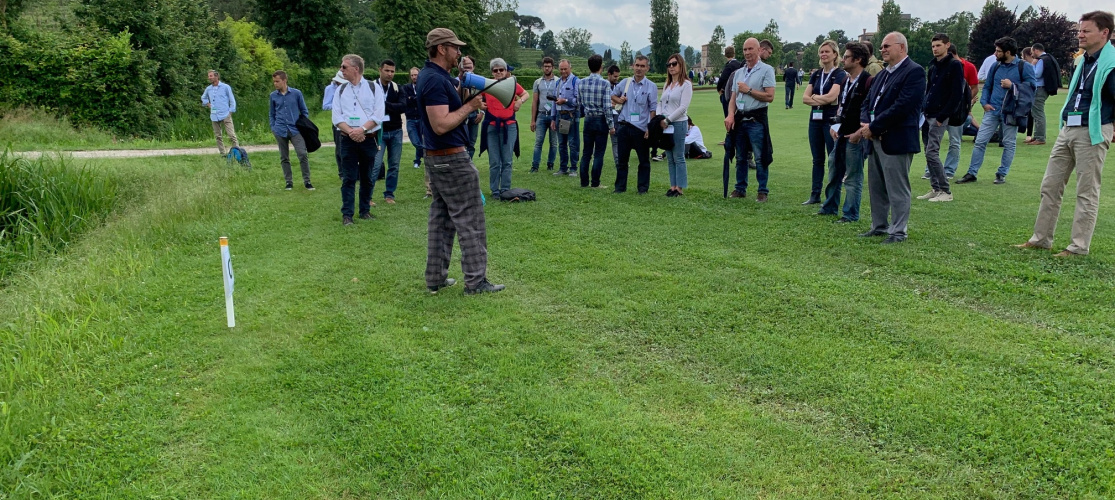

The 6th European Turfgrass Society Field Days
Alessandro De Luca - adeluca@federgolf.it
The 6th European Turfgrass Society (ETS) Field Days were held at Padova University and Montecchia Golf Club, Padova (IT), on May 27 and 28, with the theme “Transitioning turfgrasses”. Two intense days of study on turfgrasses, with more than 160 participants from Europe and also from the US took place, with a welcome mix of academics, practitioners and turfgrass industry delegates.
The main topic covered over the two days was the management of turfgrasses in the transition zone, considering new maintenance trends.
The seminars were held at the University of Padova - Campus of Agripolis - on the morning of the 27th, and at the Golf della Montecchia, Selvazzano Dentro (PD), on the morning of the 28th, while the afternoons of both days were dedicated to technical visits.
Work opened on the morning of May 27th with the invited speaker presentations given by Michel Pirchio, Researcher at Pisa University, showing the different autonomous mowing solutions and innovations. Professor Gerald Henry from the University of Georgia (USA), followed the first presentation and talked about the site-specific management for reduction of turfgrass inputs.
Professor Diego Gomez de Barreda, from the University Politecnica of Valencia (Spain), showed the challenges and opportunities for growing grass in the transition zone. Doctor Lucia Bortolini, researcher at the University of Padova, presented a study on high distribution uniformity of irrigation systems to ensure turf quality and efficient use of water. Cristina Pornaro from the University of Padova, talked about a new hyperspectral based system for the estimation of weeds and botanical composition of turfgrasses. Professor Geunhwa Jung, from the University of Massachusetts (USA), presented a study conducted at two golf courses in Japan and in South Korea, the importance of rolling fairways in order to control Sclerotinia homeocarpa(Dollar Spot) was highlighted. Discussion with questions to the speakers followed the presentations.
After lunch, the afternoon was dedicated to field visits at the Azienda Agraria Sperimentale of the University of Padova, where the participants observed the experimental parcels of some Poa pratensiscultivars, showing resistance to drought stress with different levels of fertilisation. During the field visit, a demonstration was made of a method for the determination of the optimum time for Bermudagrass seeding in the transition zone, a comparison between new Lolium perenneand Festuca arundinacea cultivars, and the possible use of Achillea millefolium for low maintenance turfgrasses.
The last visit of the day was to the Landlab Company, a research center well known for the high quality of its results.
Day 2 was held at the Golf della Montecchia, a course that has been involved in environmental sustainability for many years.
Michael Kenna, the director of the Green Section of the United States Golf Association (USGA), opened the morning seminar, talking about the US sxperiences on Sustainable Turfgrass Management, with a focus on water conservation, environmental benefits, pesticide and nutrient fate. Alessandro De Luca, responsible for the Turfgrass Section of the Italian Golf Federation, presented the “Biogolf case study”, a management project on nine out of 27 holes at Golf della Montecchia inspired by organic farming protocols. The practical implications of this project were then showed during the course visit in the afternoon, and described below.
Following De Luca, Professor Stefano Macolino from the University of Padova presented a study on the naturalization process of roughs, to enhance golf courses biodiversity and allow the reduction of management inputs. Simone Magni, researcher at Pisa University, talked about the conversion methods from cool season to warm season turfgrasses. The Superintendent of the Golf della Montecchia, Brian Og O’Flaherty, presented the positive results of the course after a conversion to Cynodon spp. (hybrid bermudagrass). Seminars were closed with the last presentation of Massimo Mocioni from Agroinnova, University of Torino, showing the different strategies for the management of the main turf diseases without the use of pesticides.
The afternoon was dedicated to the visit of the nine holes of the “Percorso verde” of Golf della Montecchia where, since January 2015, the “Biogolf case study” started. The management is inspired by the organic farming fundamental principles: enhancing all the agronomic practices to reduce the incidence of diseases, weeds and insects in terms of turf management. The involvement of four Universities(Bologna, Padova, Torino, Pisa) was fundamental to the project. To illustrate the main study in progress, the visit was organized in five Stations:
Station W
To contain the negative effect of broad leaf weeds, two different mechanical system - the harrow and the verticutter - were used and compared.
Station U
Ultradwarf bermudagrass (cv.Minverde) overseeded with Poa trivialis and disease control (Spring Dead Spot and Dollar Spot): acid injection system, aerification, plugging, iron sulfate, antagonistic microorganism, rolling.
Station O
The purpose is to create new habitats for insects to attract birdlife. As well as increasing the hard rough area, one of the methods is ti introduce scents that can attract insects that will, in turn, attract birds. Moreover, hives have been introduced to focus the attention of the players.
Station S
In winter 2017 the greens suffered cold damage, in particular in the areas most exposed to the north-east, where there was no tree and shrub vegetation able to act as a windbreak barrier against colder winds.
The study identified the suitable species ensuring at the same time the landscape, the playability and the economic sustainability.
Station B
Bunker maintenance is an important and expensive part of golf course management. A concrete based drainage system was tested in order to avoid sand contamination and to limit the growth of weeds. Zoysia matrella, a species characterized by a slow growth was sodded on the perimeter in order to limit the edge finishing.
In conclusion of the day, Alessandro De Luca and Stefano Macolino gave their warmest thanks to all attendants for their participation.
All presentations from the two days of the ETS Field Days 2019 were printed on paper and digitally and can be downloaded here: http://www.turfgrasssociety.eu/documents/
https://www.ilverdeeditoriale.com/PubFree/ETS/mobile/index.html#p=